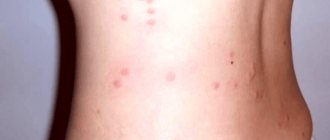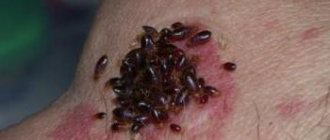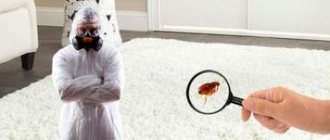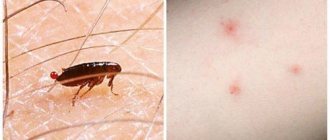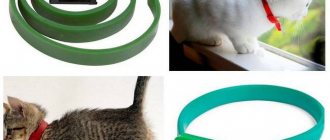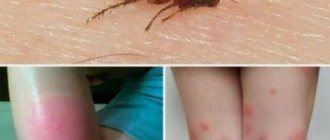The flea is a blood-sucking parasite that infects animals, birds and humans. There are more than two thousand species of fleas in the world. They are all similar in lifestyle, life cycle and damage, but they also have obvious differences. Not all types of fleas are dangerous to humans and pets. Not all of them have been studied, but almost everything is known about those living in our climate zone. You need to know exactly what types of fleas can live in an apartment or in a private household, how dangerous they are and how to deal with them.
To classify flea species, the criterion is taken as the one whose blood they feed on. This is how they distinguish between humans, cats, rats, dogs, etc. This does not mean at all that parasites have a strict and unchangeable preference for whom to bite, whose blood to drink. Only one variety feeds on the blood of a specific animal and does not change it. This is a flea that infects bats. Other varieties can bite representatives of different species. For example, dog fleas prefer the blood of dogs, but can easily bite a person or cat. Cat and dog fleas do not hesitate to bite rodents in the absence of their main victims.
What fleas live in apartments
Fleas in an apartment can live in large colonies. But even a few individuals can greatly ruin your life. In apartments you can find representatives of all types of fleas: dog, cat, rat and, of course, human.
There are no so-called indoor fleas or house fleas. They can live anywhere - in barns, warehouses, industrial premises. They are brought from the street or from other buildings into homes by rodents, cats, dogs on fur, and people on clothes or shoes. And all parasites brought from outside pose a danger to people.
Prevention
To avoid flea infestation, you need to follow simple measures:
- regularly check and clean pets from insects, as human fleas can live on them;
- to protect premises, use preventive measures - cleaning with disinfectants, spraying solutions of tansy, wormwood, clearing debris and dirt from places where fleas can live;
- use repellents when in potentially dangerous places.
In most cases, fleas are brought by pets; insects prefer to live in their warm skins. Therefore, buy a special collar for your animal and make sure that it does not come into contact with other people’s cats or dogs.
Fleas have long been a real curse of people, spreading epidemics of plague and other dangerous diseases. Modern means create a reliable barrier against all insects, but we must not lose vigilance, since at the slightest mistake, fleas will happily enter our homes.
Where do fleas live
They do not live directly on humans, like lice, for example. They jump on victims from the floor or from shelters. You can find fleas in a variety of places in your apartment:
- on a shag carpet;
- on the upholstery of upholstered furniture - sofas and armchairs;
- in bed linen and accessories;
- on pet bedding;
- behind floor skirting boards;
- behind peeling wallpaper, in cracks and crevices of the floor or walls;
- in deposits of garbage and rubbish, just old things.
Fleas do not live on the human body, but on animals they can remain in the fur for a very long time. Females lay eggs in the animal’s fur, which means insects can parasitize them on an ongoing basis.
What do house fleas look like?
You need to know your enemies by sight) Before you think about how to remove fleas, you first need to make sure that it is they who are bothering you . Whatever fleas attack you (rat, cat, dog or others), they are all about the same.
You can see in the photo what a flea looks like close up . The body is very strongly flattened laterally. On the small head there are small antennae and a pair of eyes. All legs of the parasite are highly developed. Especially the last legs. They perform a jumping function. This is clearly visible in the flea photo.
Life-size - these are most often small (about 1-3 mm), shiny, jumping “dots” . Although the color can range from yellow to brown, and the size can reach up to 5 mm. It all depends on the type and degree of maturity of the insect. They don't know how to fly. Therefore, if you see them, there is a chance to catch them with your hands. They do not run away much from the approach of a human hand. Although skill may be needed.
If such a captive is placed in a container of water, it will be very clearly visible that she is “jerking” with her paws. Fleas don't die in water, but they can't get out either . They float on the surface. Therefore, they can be examined in this way without fear that they will disappear again in an unknown direction.
Since these insects are very flat on the sides , it is almost impossible to crush them. And you shouldn't try to do this. It is better to kill fleas in large quantities . But if you catch one or two and place them in water, then pour the liquid along with the insects down the drain. Of course, getting rid of fleas in this way will not affect the overall number of parasites. But don’t let them go free...
Human fleas
In appearance they do not differ from other species. Their lifestyle is somewhat different in the sense that these jumping parasites do not live permanently on the host’s body, but come to him only for food. However, on a person with very dense body hair, they may linger.
In the absence of humans, these fleas can feed on the blood of other creatures - animals or birds.
Fleas are dangerous for humans because they carry pathogens: plague, anthrax, encephalitis, and helminthiasis.
A person feels a flea bite, and after the bite the following symptoms develop:
- redness and rashes on the skin;
- allergic reactions;
- temperature increase;
- migraine;
- enlarged lymph nodes.
The flea bites and gets fed quickly. The bite causes itching. If there are a lot of bites, this leads to nervous disorders and disruption of sleep and rest due to constant itching. A person scratches the bites, which can cause infection in the scratching. This can lead to dermatitis and other skin problems.
Signs of fleas in humans
Most often, people become infected with fleas from their pets. You can suspect the presence of bloodsuckers at home based on characteristic signs. The main one is pain at the time of the bite. The sensations depend on individual sensitivity, but, as a rule, they are more pronounced than with a mosquito bite.
Additional symptoms include:
- skin redness;
- severe itching;
- the appearance of a blister with a red dot in the center;
- swelling of soft tissues.
Flea bites are usually located 1-2 cm apart. Blisters are most often localized on the legs. If parasites have settled in the bed, then bites can appear on any part of the body.
Cat fleas
Cats usually pick up fleas on the street if they go for a walk there. They can also become infected, for example, from a dog living in the house that regularly goes for walks and brings them from the street. Even the owner's shoes and clothes can carry cat fleas into the apartment. The parasite jumps on the cat, easily makes its way through even the thickest fur, pierces the skin and sucks blood. Then the pest may leave the victim, or may remain in the thick fur. When there are too many bites, the cat becomes restless, constantly itches, bites off fur, sleeps poorly and refuses to eat.
Also, when affected by fleas, the following signs appear:
- the fur becomes dull, tangled, and forms tangles even with regular combing of the animal;
- if you look closely, you can see eggs - these are small rounded grains near the roots of the hairs;
- If you part the fur, there are bite marks on the skin - blisters, scratches, swelling and redness.
Due to constant scratching, the animal can get infections through the wounds.
Dog fleas
From the name it is clear that they prefer to drink the blood of dogs. It is very easy for a dog to become infected with fleas while walking. Moreover, the pest can jump on the pet either simply from the ground or grass, or from other animals. You can also pick up fleas in stores or other public places. Owners also bring pests into the house on their clothes, without even knowing it.
How to tell if your dog has fleas:
- constant itching, which causes the animal to itch;
- the dog tries to grab the parasite with its teeth or constantly licks itself;
- restless sleep, whining in sleep;
- decreased appetite and refusal to eat;
- deterioration of mood, apathy, irritability.
Flea infestation is usually accompanied by helminthiasis. Also, flea bites, if left untreated, can develop into dermatitis. In addition, fleas spread dangerous infectious diseases. So, at the first signs, you need to immediately carefully examine your pet to find parasites, and then contact a veterinarian if dangerous symptoms appear.
Flea control methods
In addition to the danger of contracting an infection, emerging parasites cause significant inconvenience. You can get rid of them in several ways: using improvised means; using chemical insecticidal preparations; call specialists from the sanitary and epidemiological service to your home.
Folk remedies
First of all, it is worth examining your pets and, if necessary, removing fleas from them. For this purpose, veterinary pharmacies offer many means:
Use flea drops and other pet-specific products
It is a mistaken belief that if you get rid of fleas from animals, the parasites will disappear from your home.
In addition to baiting brown bloodsuckers from pets, it is necessary to vacuum everything and carry out a thorough wet cleaning. Clean and wash carpets. Wash the floors with a solution of vinegar or tar soap. It is useful to place aromatic herbs in the corners:
Fleas do not tolerate the smell of these plants. If you sprinkle salt on the floor, these crystals corrode their outer covering, causing the death of pests. Then the salt and grass must be carefully removed.
However, this method can only get rid of adult individuals. After some time, fleas appear again. To destroy parasite eggs, stronger agents are needed.
Chemicals
Chemicals can harm more than just parasites. Residents and their pets can become poisoned. When using chemicals, safety precautions must be observed. When baiting insects, be sure to use a protective mask and gloves. Leave the room for 24 hours, then ventilate thoroughly. If one of the residents has allergies, it is better not to use this method of control.
When chemically treating an apartment, it is better to move out of it.
Most apartment owners turn to special services for help. This is the fastest, most convenient way to get rid of parasites. After the call, specialists visit your home. SES employees will help get rid of parasites, tell you what caused this attack, and give advice on how to avoid re-infiltration.
The presence of blood-sucking parasites can turn the life of not only four-legged pets, but also their owners into a nightmare. Therefore, it is worth urgently addressing the issue of cleaning your home from parasites.
Rat fleas
They prefer the blood of rodents, but in the absence of a suitable victim they also attack humans, domestic animals and birds.
Rat fleas are especially dangerous to humans and animals. The fact is that rats are very unclean. Their blood contains pathogens. A flea, biting either a rat or a person, carries pathogenic microorganisms with saliva or even just on its body. Because of this, rat flea bites can even be fatal if they are not recognized in time and the necessary measures are not taken.
Outwardly, they are no different from human or canine ones. They bite just as quickly and painfully.
Bird fleas
They are often called chicken bites because it is chickens that they bite the most. They appear if the bird walks freely in the yard. You can also bring them into the chicken coop on the clothes of the owners. Rodents also turn out to be carriers.
Chicken fleas also carry pathogenic microorganisms that cause dangerous diseases. And simply in large numbers, their bites cause anxiety to birds, which become irritable and even aggressive. Chicken fleas can be picked up by humans, as well as dogs and cats. It is quite difficult to detect fleas on a chicken because they burrow under the feathers and stay on the skin.



